Jethro Brice – Unruly Waters
Unruly Waters is an exhibition of drawings that lie alongside a series of journeys as performance on the river Avon. Using slow travel as a catalyst for conversations in situ, I aim to stimulate a renewed connection with the changeable and ‘more-than-human’ nature of the riverscape, through an evocation of its turbulent and tidal past.
The drawings bring together findings from field and studio research, exploring how a time-rich perspective can inform our appreciation of a changeable landscape. Using found imagery and materials to suggest the simultaneity of multiple temporalities, the drawings are an experimental space for creative juxtaposition, drawing a thread of continuity from counter-narratives of the past, to future prospects.
The work suggests new readings of the Bristol land- and water- scape, inviting viewers to revisit and re-imagine familiar places. As weather patterns change and floods become more frequent, is it time to let go of foundational attitudes of control and learn to live with the river’s wilder side?
The Work:
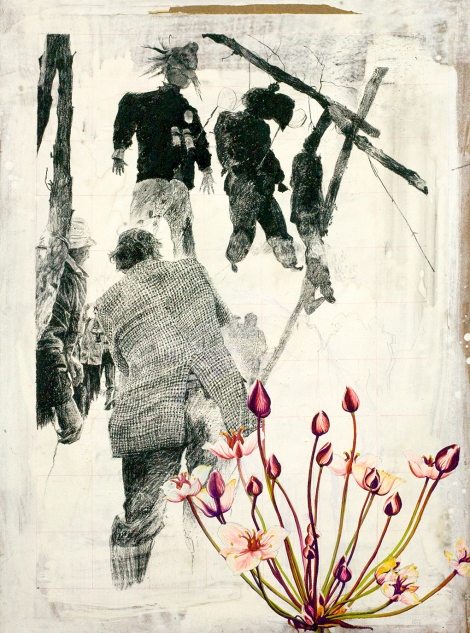
The Owners of Geese, 2013
Conté, oil pastel, pencils and gouache on spent plaster and found board, 58 x 81 cm
“They hang the man and flog the woman
Who steals the goose from off the common
Yet let the greater villain loose
That steals the common from the goose
And geese will still a common lack
Till they go and steal it back.”
Anon, English protest rhyme, c.17 or c.18
“The Somerset commoners succeeded in fighting off most attempts at drainage where their contemporaries in the eastern counties had failed. After 1638 nearly two-thirds of the Somerset Levels were still unreclaimed, and even as late as 1769, the local drainage agent, Rickard Locke, was stoned, and his effigy was burned ‘by the owners of geese’. Old habits die hard in the wetlands. In 1983 the descendants of these owners of geese were to burn the local conservationists in effigy.”
Jeremy Purseglove, ‘Taming the Flood’
“The rhynes exhibit a rich flora including locally rare species such as the Flowering Rush Butomus umbellatus…”
Natural England, ‘West Sedgemoor SSSI’
“The only remaining UK populations of the flowering rush weevil are found on the Somerset Levels.”
Somerset Wildlife Trust, ‘Species in Decline in Somerset by Habitat’
‘Between the Tides’ – exchange workshop 3
“Thus was created the now infamous ‘trapezoidal channel’ recommended as the basic formula for a new engineered watercourse. A trapezoid, of course, is a mathematical figure, similar to a trapezium; so eloquent is the basic jargon of a fundamental clash of values: river as geometry”
“It really was exasperating to observe how the natives seemed to like their marshes. William Elstobb found the eighteenth-century fenmen content with ‘uncomfortable accommodations’; and Vancouver wrote of Burwell in 1794: ‘Any attempt in contemplation of better drainage of this fen is considered hostile to the true interests of these deluded people.’”
Jeremy Purseglove, ‘Taming the Flood’
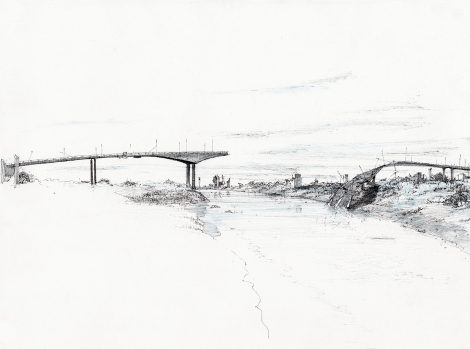
The M5 Bridge at Avonmouth, as Seen From the Sea Wall at Pill, 2010
Marker and drawing pen on paper, 42 x 30 cm
“To draw is to look, examining the structure of appearances. A drawing of a tree shows, not a tree, but a tree-being-looked-at. Whereas the sight of a tree is registered almost instantaneously, the examination of the sight of a tree (a tree- being-looked-at) not only takes minutes or hours instead of a fraction of a second, it also involves, derives from, and refers back to, much previous experience of looking. Within the instant of the sight of a tree is established a life-experience. This is how the act of drawing refuses the process of disappearances and proposes the simultaneity of a multitude of moments.”
John Berger, ‘Drawn To That Moment’

An Unexpected Encounter (the second leg), 2013
Ballpoint , pencils and pastel in found ledger, 20 x 32 cm
“Finally, one other figure appeared among the fools and vagabonds in my image search – a black slave on a Wanted poster offering a reward for captured fugitive slaves. At the party in Saltford I fell into conversation with N, a volunteer at the Saltford Brass Mill museum, who told me that the canalisation of the River had opened up supply routes for the industrialisation of the valley, including the Brass mill which produced pots and dishes for exchange for slaves in Africa on the first leg of the Atlantic triangle. It seems the colonisation of Africa and the new world accompanied a more local colonisation of Bristol’s rural hinterland, each reliant on the other. Labour conditions in the mills were probably not far removed from slavery, and the profit from all arms of the enterprise would have found its way back to the coffers of Bristol’s wealthy merchant class. [Interestingly, when slavery was finally abolished (due largely to the frequent and costly slave resistance in the colonies), slave owners were paid vast sums of public money in compensation, which they used to build new mills on the Avon employing local bonded labour]. This first journey on the river has yielded the kind of layered history I was seeking, and already it is further-reaching and more entangled than I had anticipated.”
Jethro Brice, unrulywaters.wordpress.com
“Cranes are wonderful, iconic birds that are sadly missing from many of their former wetland haunts in the UK. They were lost as a breeding bird around 400 years ago as a result of the draining of their wetland nesting sites, and hunting for food.
“Since 2010 , the project has focused on the reintroduction of cranes into the Somerset Levels and Moors – 60,000ha of floodplain in the South West of the UK, dominated by extensive mixed pastures, meadows and wetlands.”
RSPB, ‘The Great Crane Project’
“Once tidal and unruly as far as Bath, the River Avon has been extensively reworked over the years; its borderlines gradually fixed and encroached upon by stone and concrete, weirs and towpaths. A literal eye scanning the familiar place names encounters a wetter landscape – Canon’s Marsh, St Augustine’s Reach, Broad Mead, St Phillip’s Marsh. Beyond the closely managed confines of the city, extreme weather events reassert the Avon’s former expansiveness.”
Jethro Brice, ‘Unruly Waters’
”…Each generation comes to view the environment into which it was born as natural, or normal. Shifting environmental baselines cause a collective societal amnesia in which gradual deterioration of the environment and depletion of wildlife populations pass almost unnoticed. Our expectations diminish with time, and with them goes our will to do something about the losses.”
Prof. Callum Roberts, ‘The Unnatural History of the Sea’
“…we are eating today what our grandparents used as bait.”
Daniel Pauly, ‘Fishing Down Marine Foodwebs’
“The place name ‘Saltford’ is Anglo-Saxon, although there are at least three possible meanings for the name, which people argue about. It could mean ‘Salt Ford’, because in those days there were no weirs on the River Avon and water here could have been salty, whereas, the tidal salt water did not reach the riverside village of Freshford, on the Avon to the east of Bath.
“The Domesday Book entry for this place was ‘Sanford’ and that could have come from ‘Sand-ford’ because the banks are sandy. Equally interesting are early references to ‘Saehl ford’, meaning ford of the willows. That is also plausible indeed, you will see many picturesque willows along the bank here.”
Dick Bateman, discoveringbritain.org
“Fracking is a hot topic these days, especially in Keynsham where UK Methane intend to request planning permission to extract coal bed methane within a mile of the high street (we are still waiting for a full planning application to be submitted).”
Transition Keynsham
“There is a substantial amount of evidence documenting the side effects of hydraulic fracturing, the majority of which are related to water contamination.”
Frack Free Somerset
“Keynsham and the surrounding locality contains localised areas that are prone to flooding from a range of sources including rivers, sewers, land, and groundwater. The type of flooding is dependent on the interaction of rainfall, catchment characteristics and the sea. PPS25 identifies six sources of flooding to be investigated in an SFRA as flooding from rivers, the sea, groundwater, land, sewers and artificial sources.”
“Flooding most frequently occurs on the extensive natural washlands and ‘functioning floodplain’ adjacent to the Avon…”
BaNES CC, ‘Strategic Flood Risk Assessment of Bath and North East Somerset’
“The River Regeneration Trust was formed earlier this year out of B&NES River Corridor Group and has received £100,000 funding to carry out a scoping study for the stretch of the River Avon known as the Broadmead Peninsula. Group Chairman Geoff Dunford explained that this was a isolated area of land between the railway land and the river which, because of the boundary between two local authorities, had received little attention in the past.
The aim is to create homes, jobs and leisure pursuits in the area while at the same time, dealing with future flood issues. A key part of the study, is to connect the town of Keynsham to its river, something which has been done successfully in other parts of the country.
The Week In, ‘Keynsham-on-Avon’
“Historically, boats travelling this stretch would tie up at regular intervals along the banks to await the next favourable tide. In this project, current tidal tables will be used to programme and situate a series of community events on a ‘tidal’ journey along the river. Artists will use their individual skills and expertise to facilitate an exploratory process in which participants develop a new creative response to an aspect of the former tidal landscape.”
Jethro Brice, ‘Tidal Recall’

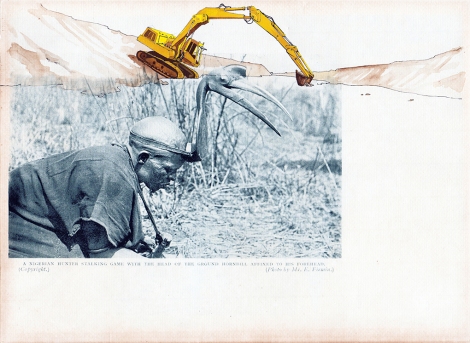

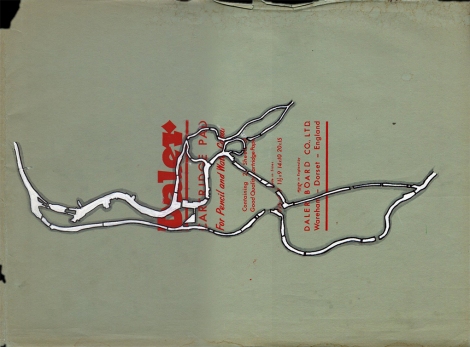




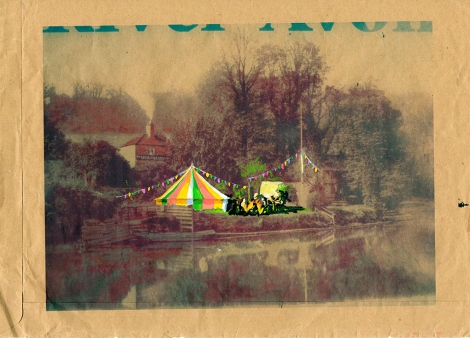
I’m in touch by email and hoping to buy Tidal Recall as a print as I understand the original has been sold already. Love your work! :)
I just bought some lovely cards at the Watershed, and thought maybe they’d sell some of your cards? If you’re interested, get in touch with Paul, through info@watershed.co.uk I think they’d be popular there! :-)
And I’m also wondering if you’ve ever thought of exhibiting at the bear pit? I don’t know what the protocol is there, whether it’s just fly post whatever you like, or if there’s someone organising it, but you could put up some nice big poster prints of some of your work, and lots of people would see it without having to go into an exhibition… :-)
Pingback: Drawing in the Fluid Tense | Unruly Waters·
Pingback: Dutch-UK knowledge exchange event on Tuesday 7th Oct | some:when·